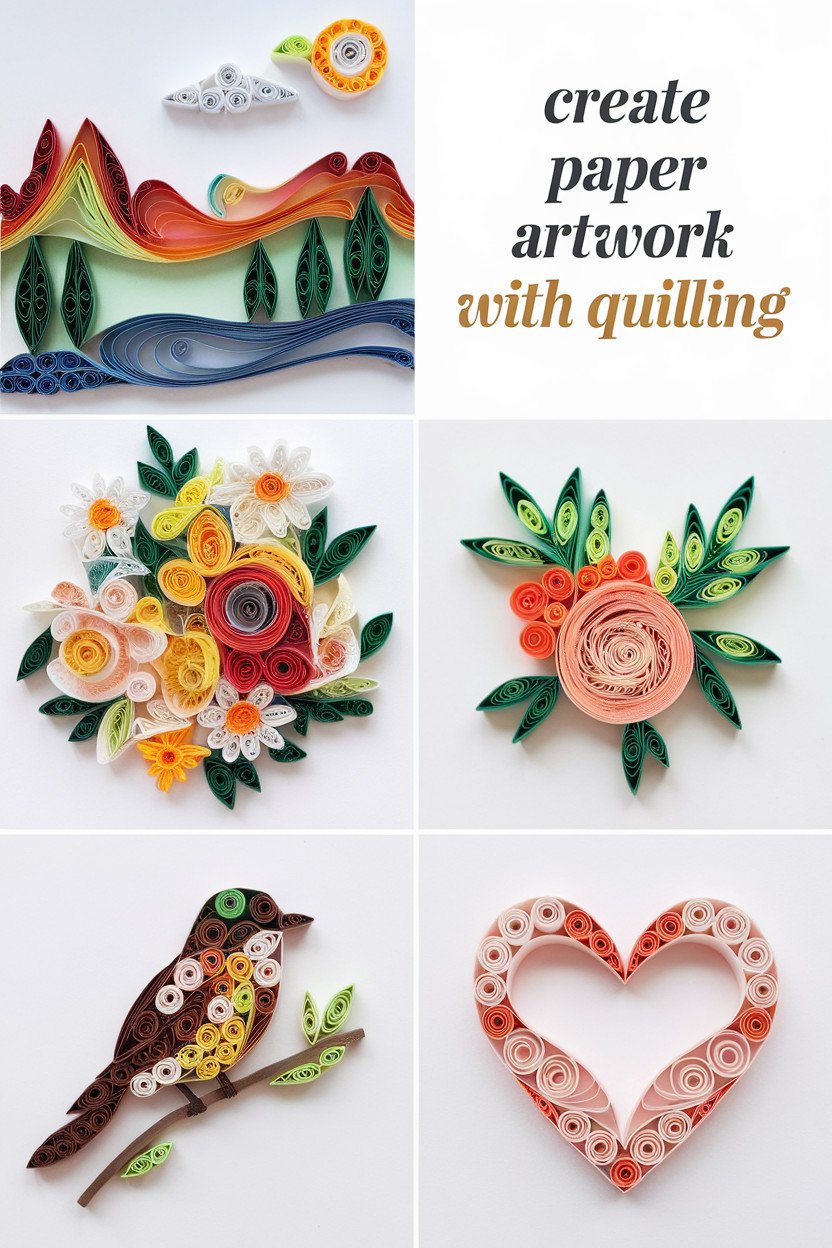Quilling, also known as paper filigree, is a technique of rolling and shaping thin strips of paper into intricate designs. With the right tools and techniques, you can create stunning quilled artworks that will amaze your friends and family.
From simple shapes and patterns to advanced compositions, quilling allows you to express your artistic vision and create unique paper art.
Key Takeaways:
- Quilling Paper Art is a technique of rolling and shaping thin strips of paper into intricate designs.
- Quilling offers endless possibilities of crafting with paper for all skill levels.
- Quilling can help you express your artistic vision and create unique designs.
- Join the community of quilling enthusiasts to learn and share your work.
- Start your paper art journey today and unlock your creativity with Quilling Paper Art.

All About Quilling Paper Art
Quilling, also known as paper filigree, dates back to the Renaissance period when monks used thin strips of gold to decorate religious texts. Today, Quilling Paper Art has evolved into a popular craft that allows you to create intricate designs and beautiful Quilled artworks.
Quilling designs can range from simple shapes to more complex patterns that resemble filigree jewelry.
With endless possibilities, Quilling is a versatile art form that can be used as a creative outlet or to enhance your home decor. Some of the most popular Quilled artworks include floral motifs, animals, and abstract designs.
- Quilling involves creating shapes by rolling, folding, and twisting strips of paper into unique designs.
- You can use a variety of paper types, including colored, metallic, and patterned paper.
- Quilling tools such as a slotted tool, tweezers, and a glue applicator are essential for precise and efficient crafting.
- Quilled artworks can be framed or used to embellish greeting cards, gift boxes, and other surfaces.
Getting Started with Quilling
If you’re ready to start your quilling journey, the first step is to gather the necessary supplies. You’ll need:
- Quilling paper strips
- Quilling tool, such as a slotted quilling tool or needle tool
- Glue
- Scissors
- Tweezers (optional but useful for handling small pieces)
Once you have your supplies, it’s time to learn the basic techniques. Follow step-by-step tutorials online or in quilling books, or watch instructional videos. Some common techniques to master include:
- Rolling: rolling strips of paper tightly around a tool to create coils
- Loose coil: creating a circle with a strip of paper and pinching one side to create a teardrop shape
- Marquise: creating a closed loop with a strip of paper and then creating a pointed shape on one end
- Triangle: creating three closed loops with strips of paper and then joining them together

Remember to start with simple designs and work your way up to more complex patterns. With practice and patience, you’ll soon be creating stunning quilled artworks!
Exploring Quilling Patterns
Quilling designs are as diverse as they are beautiful. Once you’ve learned the basic techniques of paper quilling, you can start experimenting with different patterns to create stunning artworks. Here are some popular quilling patterns to explore:
- Loose Coils: This is the foundation of most quilled designs. Simply roll the paper strip tightly and release to create a loose coil. This shape can be combined with other shapes to create more complex designs.
- Tight Coils: Roll the paper strip tightly to create a small, dense coil. This shape can be used to create flower petals, animal ears, and other fine details.
- Teardrops: Pinch one end of the loose coil to create a teardrop shape. This shape can be used for flower petals, leaves, and other organic shapes.
- S-shapes: This shape is created by bending a paper strip into an S-shape. It can be used to create waves, curves, and other dynamic elements in your design.
- Husking: This technique involves creating a pattern of loops around a central shape. It can be used to create flowers, stars, and other intricate designs.
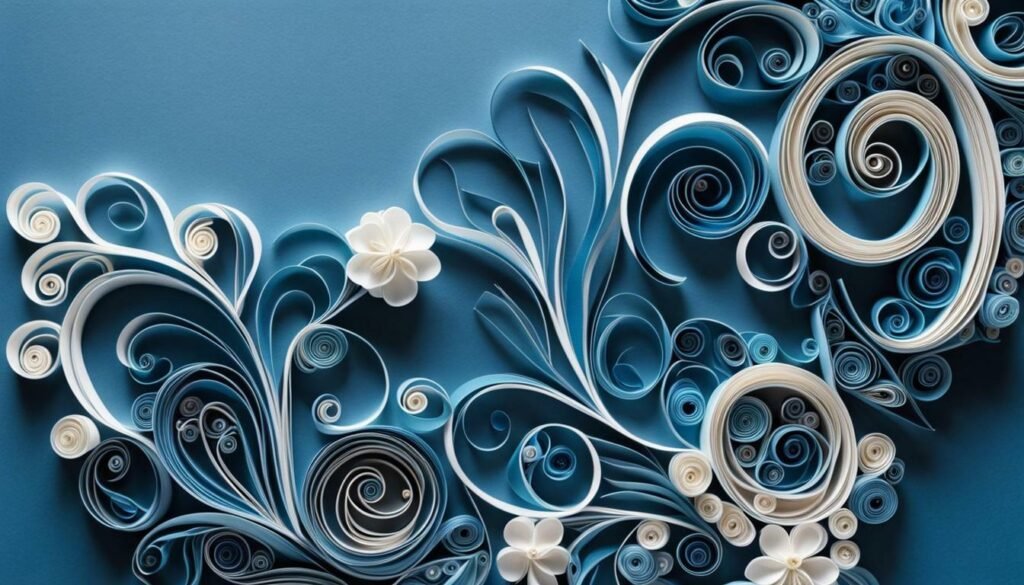
Exploring different quilling patterns can help you develop your own style and create unique artworks.
Quilling Ideas for Home Decor
Here are some quilling ideas to get you started:
- Create a quilled monogram to add a personal touch to your wall decor.
- Make colorful quilled flowers to brighten up a plain vase or picture frame.
- Quill a beautiful landscape or cityscape and frame it as wall art.
- Make a quilled heart or star to decorate a gift box or greeting card.
These are just a few quilling ideas to inspire your creativity. With quilling techniques, you can customize your home decor to your liking.
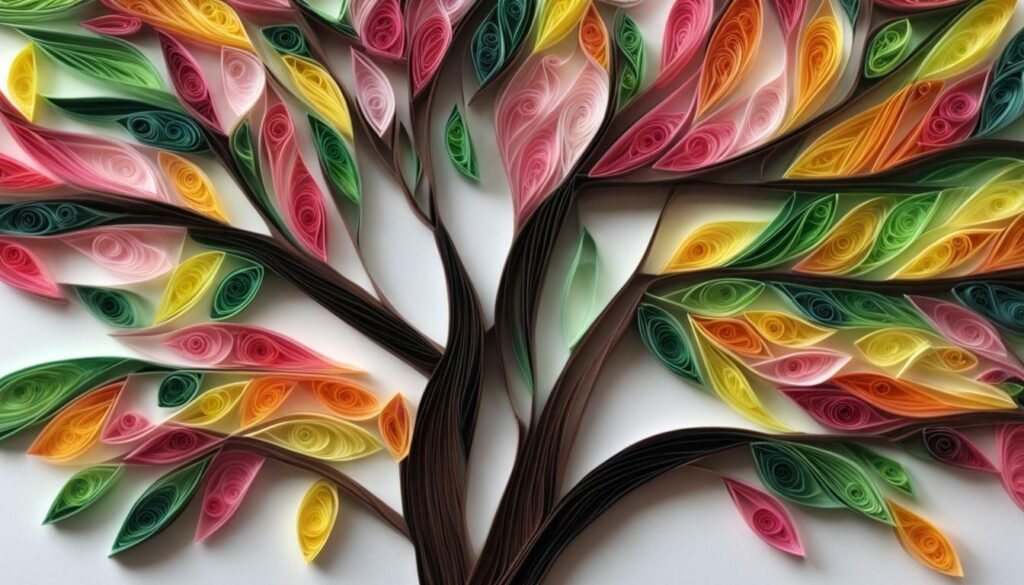
If you’re looking for unique and creative ways to decorate your home, quilling paper art is the perfect solution. Here are some quilling ideas to consider:
- Quill a beautiful mandala and frame it as wall decor.
- Create a quilled butterfly mobile to hang in a child’s room.
- Make a quilled teardrop design and display it in a shadow box for a three-dimensional effect.
- Quill a whimsical fairy tale scene and frame it as wall art.
Quilling Techniques for Beginners
Here are some beginner-friendly quilling techniques to get you started:
- Rolling: The most basic quilling technique involves rolling strips of paper into tight circles. This is the foundation for most quilled designs.
- Looping: This technique involves creating teardrop or eye-shaped loops by pinching and releasing the rolled paper. These loops can be used to create petals, leaves, and other shapes.
- Coiling: Coiling is similar to rolling, but the paper strip is wrapped around a tool (like a toothpick or quilling needle) to create a looser, more open spiral.
Once you have mastered these techniques, you can experiment with different shapes and patterns to create intricate quilling designs.

Here are some tips to keep in mind as you embark on your quilling journey:
- Start with simple designs and work your way up to more complex patterns.
- Choose high-quality paper that is easy to roll and manipulate.
- Use a quilling tool to make rolling easier and more precise.
- Work on a flat surface with good lighting so you can see your work clearly.
- Keep your quilled pieces in a dry, cool place to prevent them from warping or bending.
Advanced Quilling Techniques
Ready to take your quilling skills to the next level? These advanced techniques will help you create impressive and intricate paper art.
- Layering: Experiment with layering different quilled shapes to create depth and dimension in your artwork.
- Fringing: Make tiny cuts into the edges of your quilled shapes to create a fringe effect, adding texture and interest to your designs.
- Coiling: Use a quilling tool to create tight coils, then shape them into various forms, such as flowers or animals.
- Combining techniques: Combine different quilling techniques, such as layering and coiling, to create complex and unique designs.
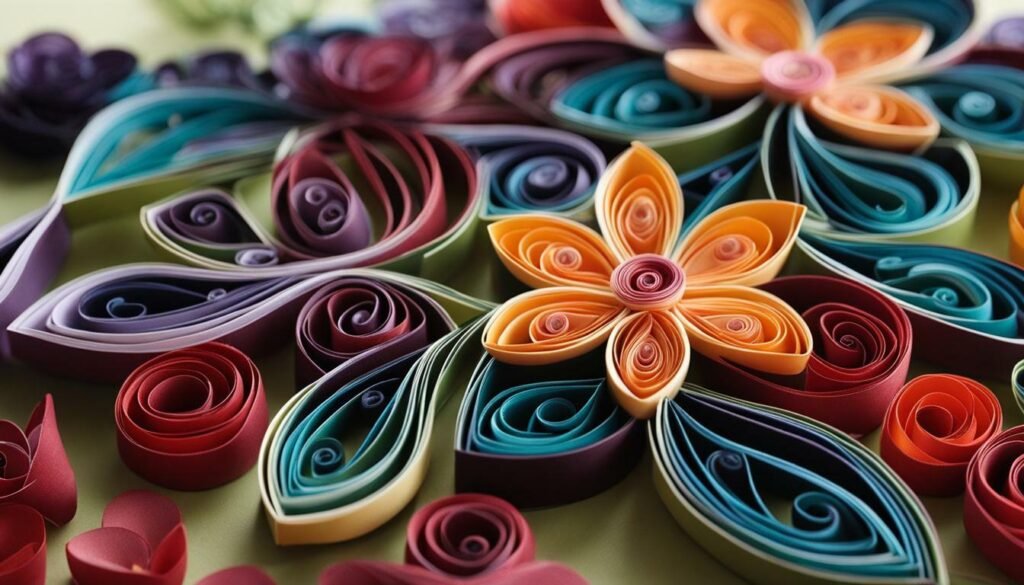
Quilling Tips and Tricks
Quilling Paper Art can be challenging but rewarding, and with these tips and tricks, you can enhance your quilling skills and create stunning paper art projects.
- Use a quilling tool to shape your paper strips instead of your fingers. This will help you create consistent and precise shapes.
- Experiment with different paper widths to add depth and texture to your designs.
- Place a piece of wax paper over your design to prevent it from sticking to the surface while you work.
- Try using tweezers to handle small or fragile pieces.
- Apply glue sparingly with a toothpick or a paper clip to avoid excess glue marks on your paper art.
- Use a quilling mold to create uniform and symmetrical designs.
- Practice your quilling skills on scrap paper before starting a new project to avoid mistakes and wasting materials.
- Find inspiration from other quilling artists or try incorporating different materials into your designs, such as beads or fabric.
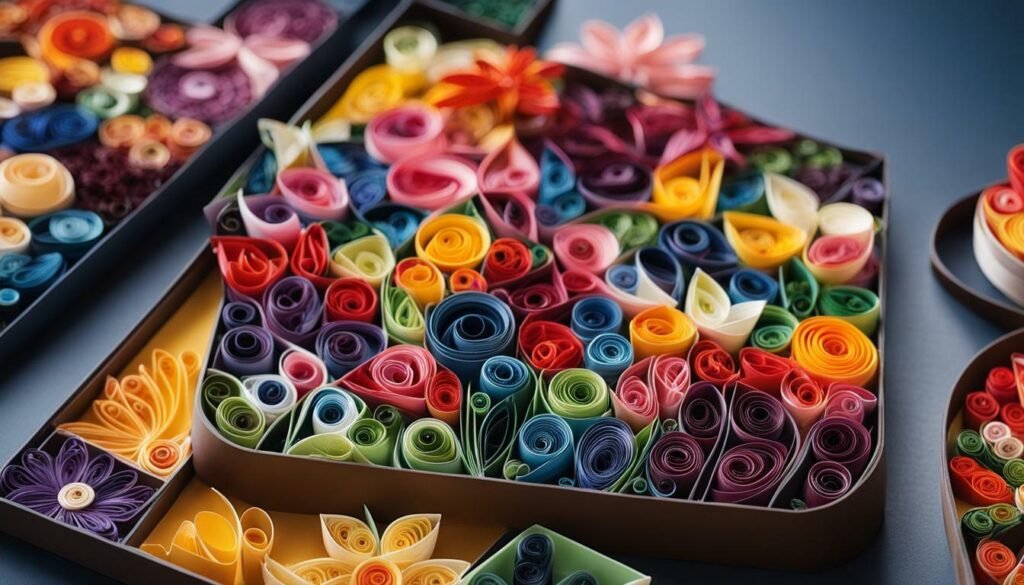
To create stunning paper art through quilling, you will need a few basic supplies. With the right materials, you can take your quilled artworks to the next level. Here are some essential quilling supplies that you should have:
- Quilling paper strips in various colors and sizes
- Slotted quilling tool or needle tool
- Scissors
- Glue
- Tweezers
- Quilling board or template
You can find these quilling supplies at your local craft stores or online.
When choosing your quilling paper strips, consider the thickness and texture of the paper. Opt for acid-free and durable paper to ensure that your quilled art will last longer.

Invest in a high-quality slotted quilling tool or needle tool to make the process of rolling and shaping the paper strips easier and more efficient.
A quilling board or template can help you create consistent shapes and sizes in your quilled artworks. You can experiment with different tools and materials to find your preferred techniques and styles in quilling.
Quilling Inspirations from Artists
- Check out Instagram accounts like @paper_artist_anna and @quilling_wonderland for a daily dose of quilling inspiration.
- Explore the works of established quilling artists like Yulia Brodskaya and Sena Runa.
- Join online artist communities like Quilling Guild and Quilling Superstars to connect with other quilling enthusiasts and learn from their techniques and styles.

If you’re looking for a unique and personalized gift or decoration for a special occasion, quilling paper art is a great option. Here are some ideas to get you started:
- Create a quilled floral monogram for a wedding or anniversary gift.
- Make a quilled paper heart to celebrate Valentine’s Day.
- Design a quilled Christmas tree ornament for the holidays.
- Quill a baby’s name for a personalized nursery decoration.

Turning Quilling into a Business
With the rising popularity of paper crafts, there’s an increasing demand for unique and handmade paper art. Here are some tips to help you get started:
- Set up an online shop on platforms like Etsy or Big Cartel to showcase your quilled artworks and take orders.
- Build a portfolio of your best work and create a social media presence on platforms like Instagram and Facebook to attract potential customers.
- Price your artworks fairly by factoring in the cost of supplies and your time and effort.
- Offer customized quilling designs for special occasions like weddings, birthdays, and anniversaries.
- Attend craft fairs and markets to showcase your work and connect with customers and other quilling enthusiasts.
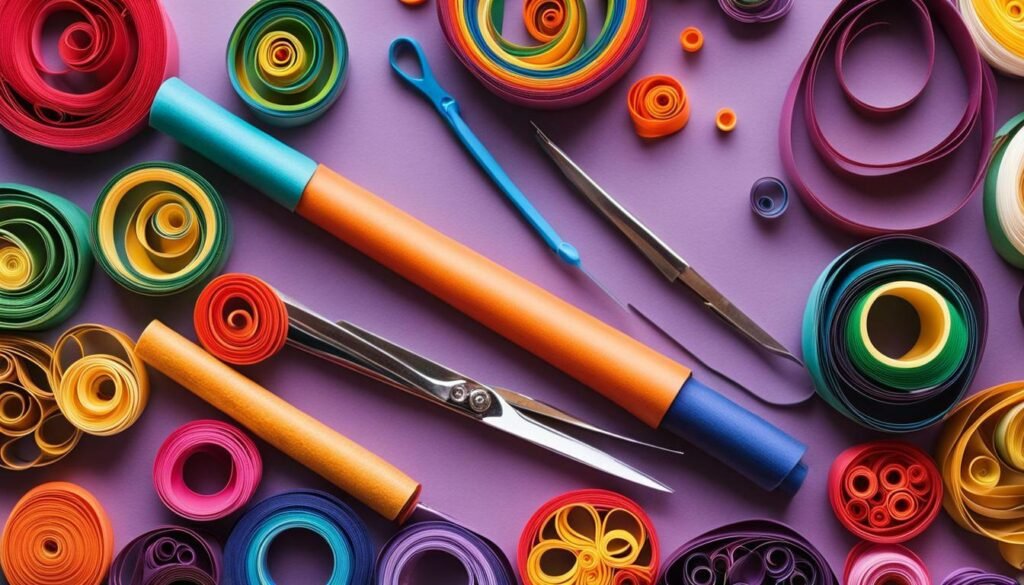
If you have kids who are interested in art and crafts, quilling can be a great activity to introduce them to. The technique is simple and easy to learn, making it perfect for children of all ages.
To get started, make sure you have all the necessary supplies, including quilling paper strips, a quilling tool, and glue. You can find many kid-friendly quilling tutorials online that are both fun and educational.
Focus on teaching them basic techniques such as rolling, folding, and shaping paper strips into various forms.
You can also encourage your child to experiment with different colors and patterns to create their own unique designs. They can even use their quilled creations to decorate cards, bookmarks, and other small items.
- Quilling teaches kids to be patient and creative, while also developing their fine motor skills.
- It provides a fun and engaging way for them to express their creativity and imagination.
- Quilling can also be a great bonding activity for parents and children to do together.
If you’re looking to connect with others who share your love for Quilling Paper Art, consider joining online communities. Facebook groups like Quilling Community, Quilling Inspiration, and Quilling Ideas offer a platform to share your work, get feedback, and learn from fellow artists.
Attending quilling events can be a great way to connect with the creative community. Check out local craft fairs and art festivals for opportunities to see quilled artworks and meet other quilling enthusiasts.
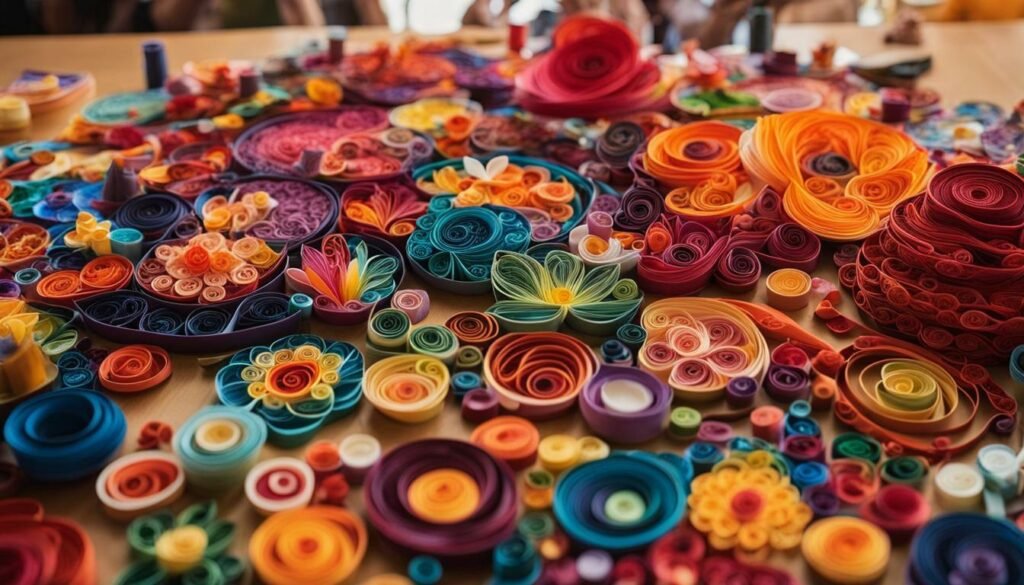
Quilling as Therapy and Relaxation
This creative hobby can serve as a therapeutic activity that allows you to focus your mind and escape from daily stressors.
As you quill, you can enter a meditative state that promotes mindfulness and calmness. This can help reduce anxiety and alleviate symptoms of depression.
Quilling is also a great way to express your emotions and channel your creativity. By creating beautiful and intricate designs with paper, you can tap into your inner artist and feel a sense of accomplishment and pride in your work.
If you’re new to quilling or looking for inspiration, try following online tutorials or joining a quilling community. Engaging with others who share your passion can provide a sense of belonging and support, and help you develop your skills.
Remember, the beauty of quilling paper art is not just in the end result, but in the process itself. So take some time for yourself, grab your quilling supplies, and let your imagination run wild!
Wrap Up: Your Quilling Journey Begins!
Congratulations on embarking on your quilling journey! You’ve learned about the art of quilling, discovered different patterns and designs, and explored beginner and advanced techniques. Now it’s time to create your own quilled masterpieces!
Here are some key takeaways to keep in mind:
- Always start with the right tools and materials to ensure high-quality results.
- Practice the basic techniques before moving on to more advanced ones.
- Explore different shapes and patterns to spark your creativity.
- Connect with other quilling enthusiasts to share your work and learn from others.
- Use quilling as a therapeutic and relaxing activity to reduce stress.
Remember, quilling is all about having fun, experimenting with different techniques, and letting your imagination run wild.
FAQ
What is quilling paper art?
Quilling paper art is a form of crafting that involves rolling and shaping thin strips of paper to create intricate designs and patterns.
Where does quilling paper art originate from?
Quilling paper art has a rich history that dates back to the Renaissance period, where it was used to decorate religious artifacts and book covers.
What can I create with quilling paper art?
With quilling paper art, you can create a wide range of designs, including flowers, animals, landscapes, and even personalized greeting cards.
What supplies do I need to start quilling?
To start quilling, you will need quilling paper strips, a quilling tool, glue, and a quilling board or template.
Are there any tutorials available for beginners?
Yes, there are plenty of online tutorials and step-by-step guides available that can help beginners learn the basics of quilling paper art.
Can I use quilling paper art for home decoration?
Absolutely! Quilling paper art can be used to create stunning decorations for your home, including wall art, framed designs, and even decorative objects.
Are there any advanced quilling techniques to explore?
Yes, once you have mastered the basics, you can explore advanced quilling techniques such as 3D quilling, quilling with metallic paper, and combining different shapes.
How can I troubleshoot common issues while quilling?
If you encounter any issues while quilling, such as unraveling coils or difficulty shaping the paper, you can find helpful tips and tricks online or seek guidance from experienced quillers.
Where can I find high-quality quilling supplies?
There are numerous online retailers and craft stores that offer a variety of quilling supplies, including specialty quilling papers, tools, and adhesive options.
Can I turn my quilling passion into a business?
Yes, many quillers have successfully turned their passion for quilling into a profitable business. You can sell your quilled artworks online, at craft fairs, or even offer custom-made designs.
Is quilling suitable for children?
Quilling can be a fun and educational activity for children, as it helps develop their fine motor skills and encourages creativity. There are also simplified quilling techniques specifically designed for kids.
How can I connect with other quilling enthusiasts?
You can join online quilling communities, participate in forums, and attend quilling events or workshops to connect with other quilling enthusiasts, share your work, and learn from each other.
Can quilling be a therapeutic and relaxing activity?
Yes, many people find quilling to be a calming and therapeutic activity that helps reduce stress and promote relaxation. It allows you to focus on the creative process and enjoy the meditative aspect of working with paper.
How can I get started with quilling?
To get started with quilling, gather your supplies, follow tutorials to learn the basic techniques, and practice regularly. Remember to have fun and let your creativity flow!
